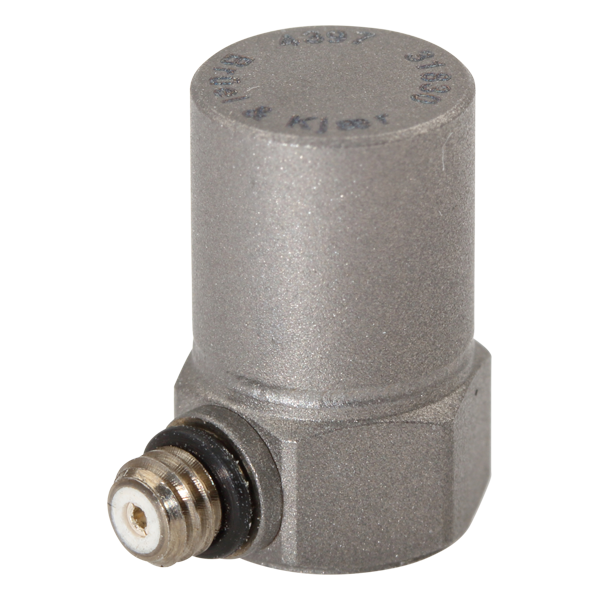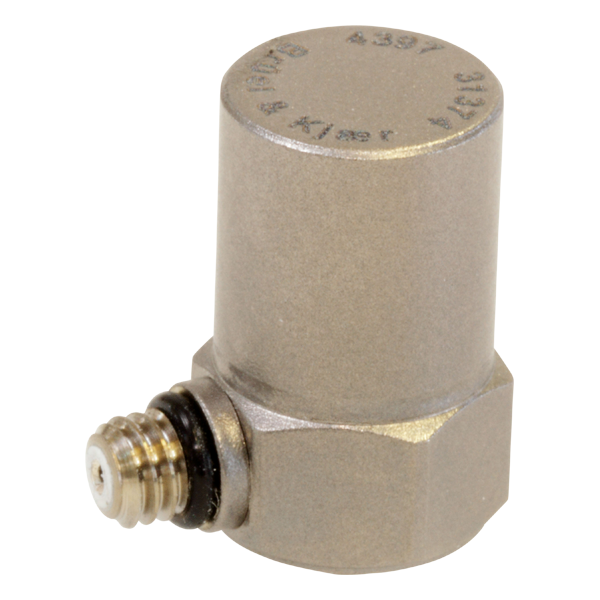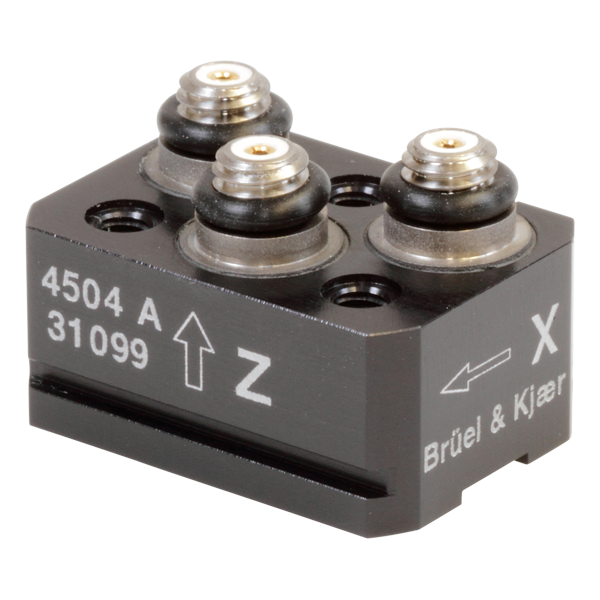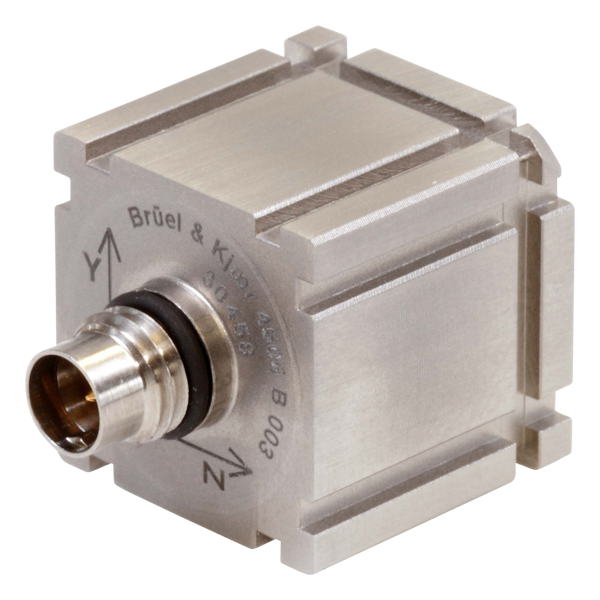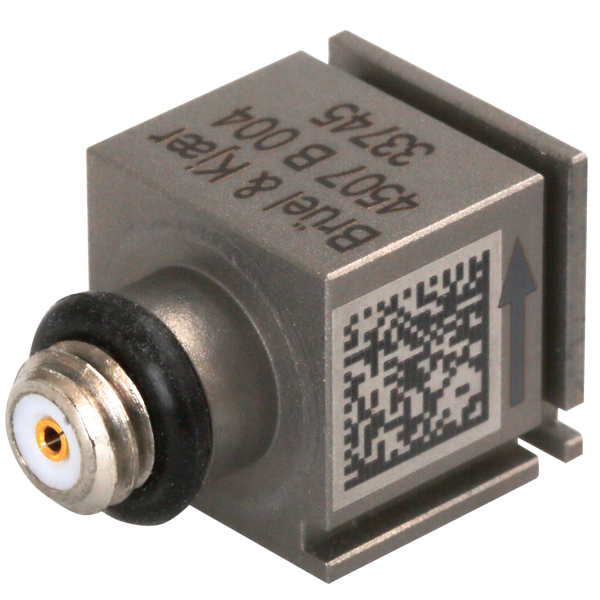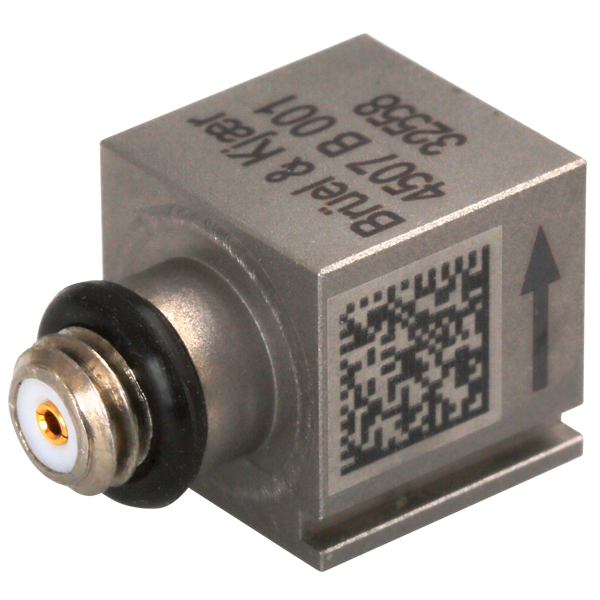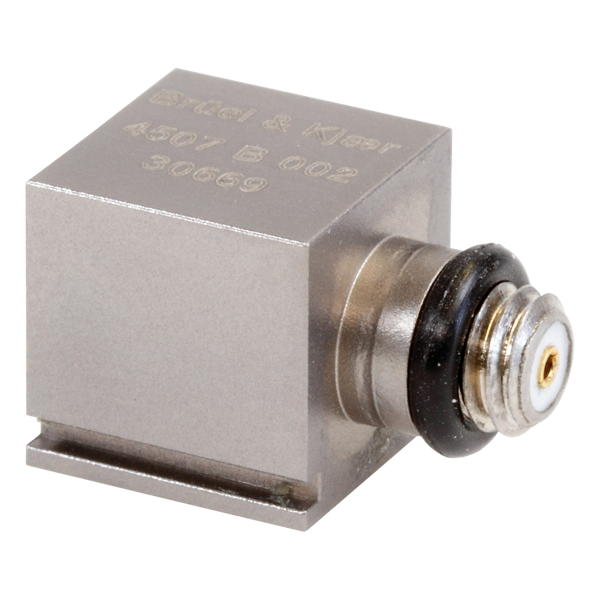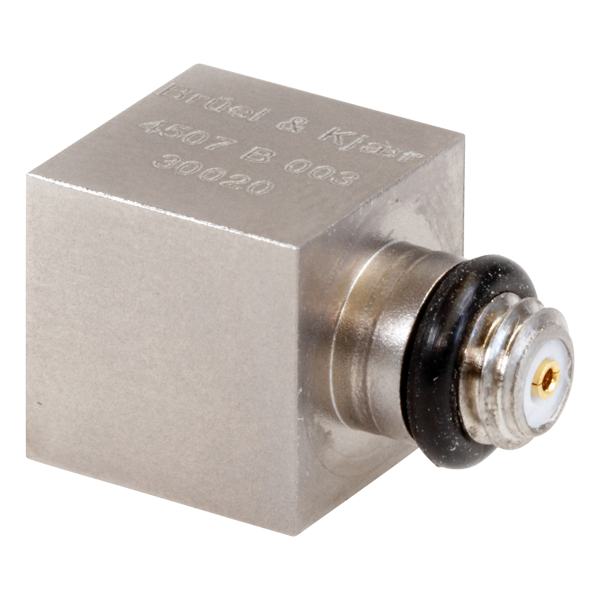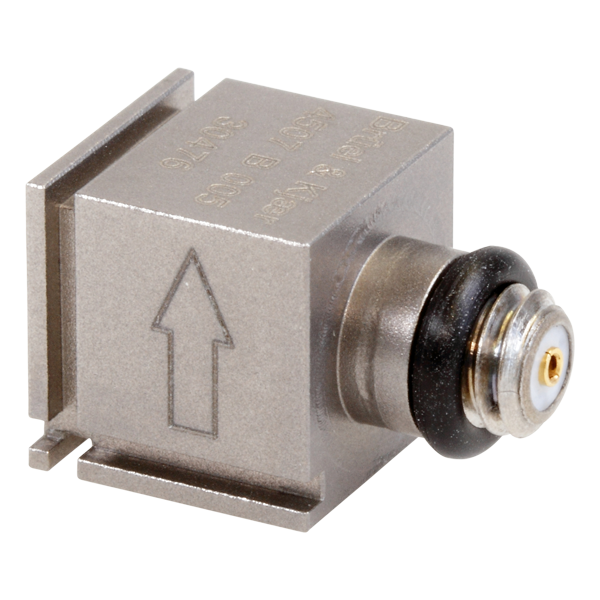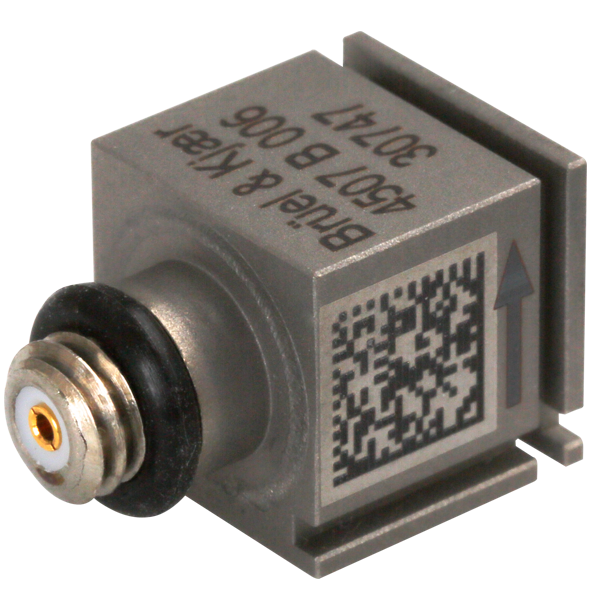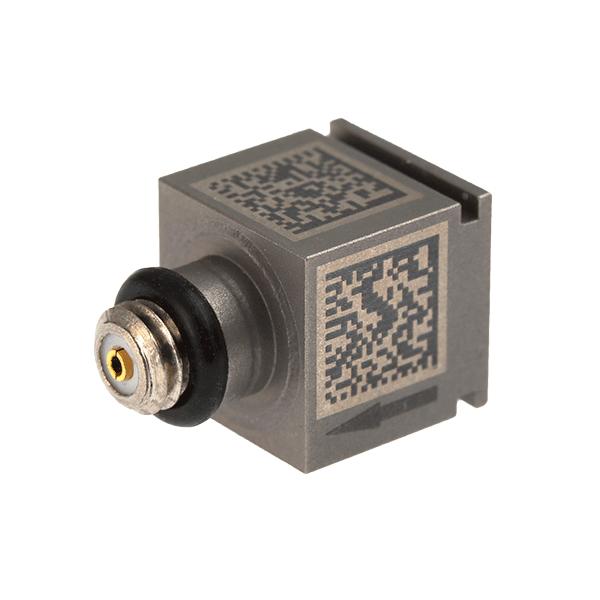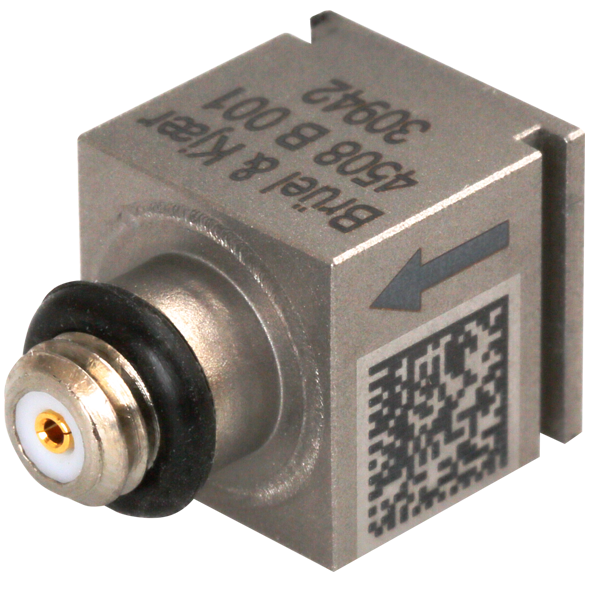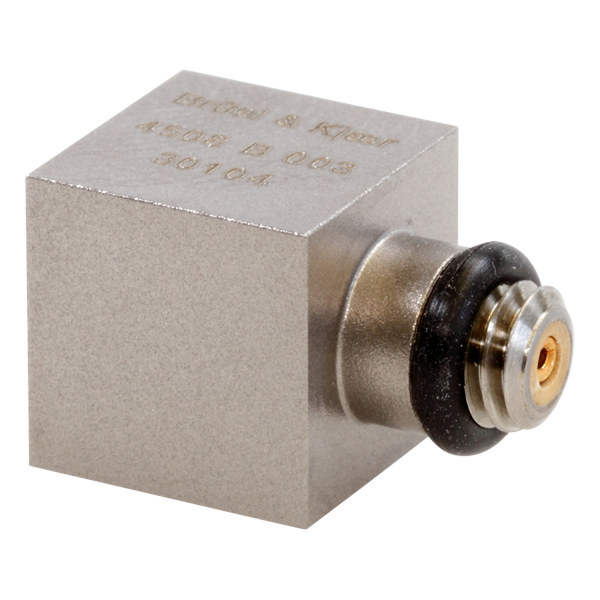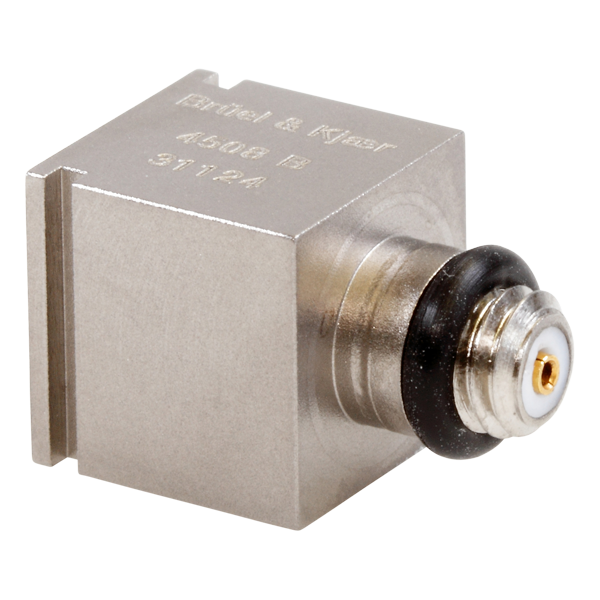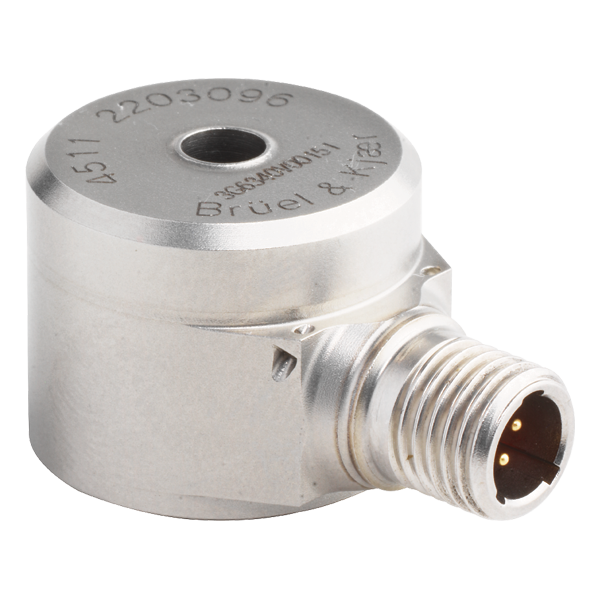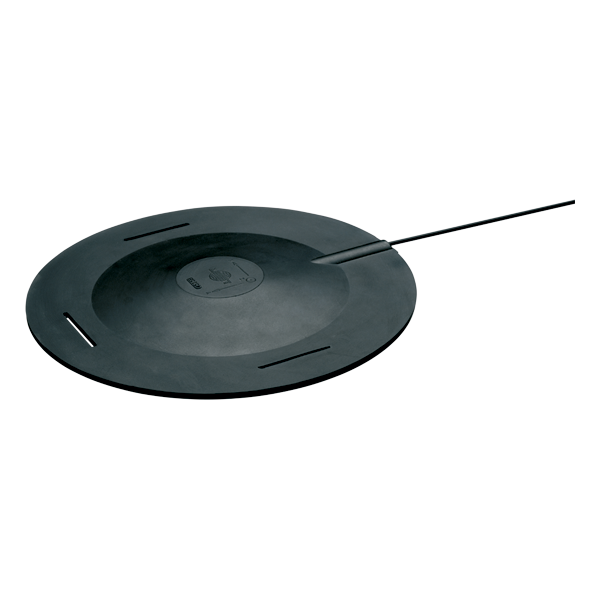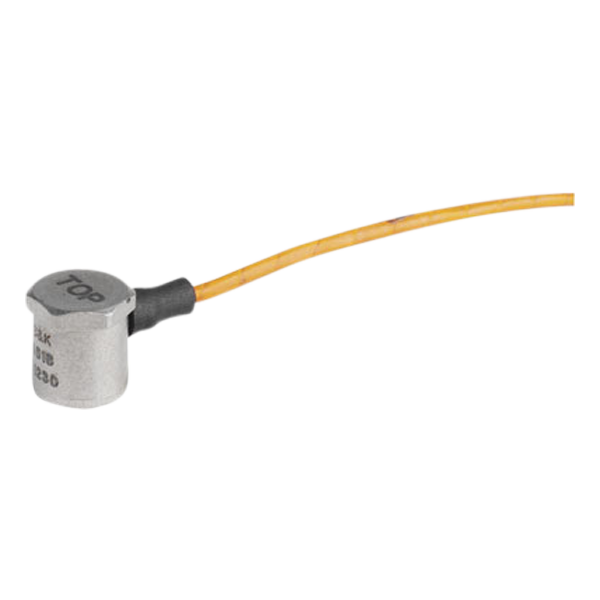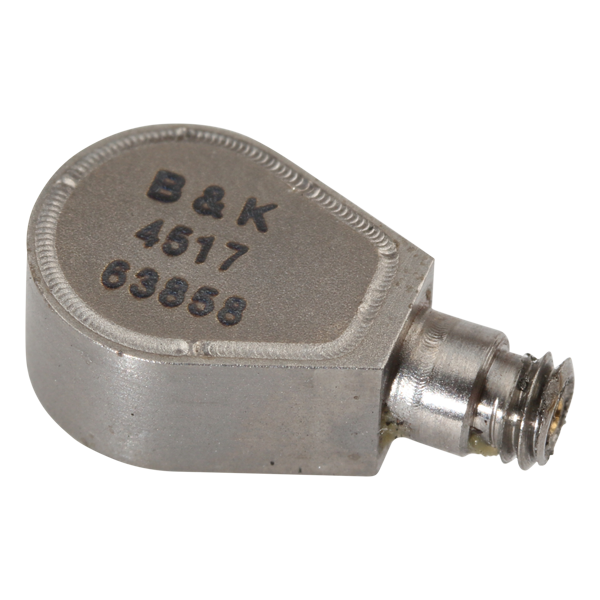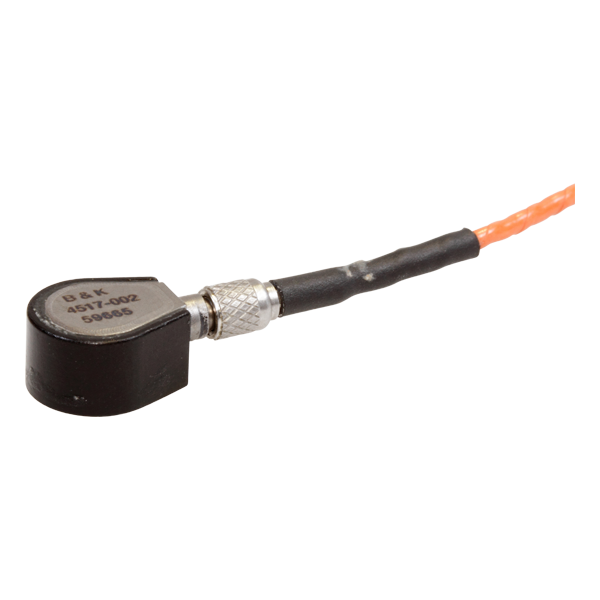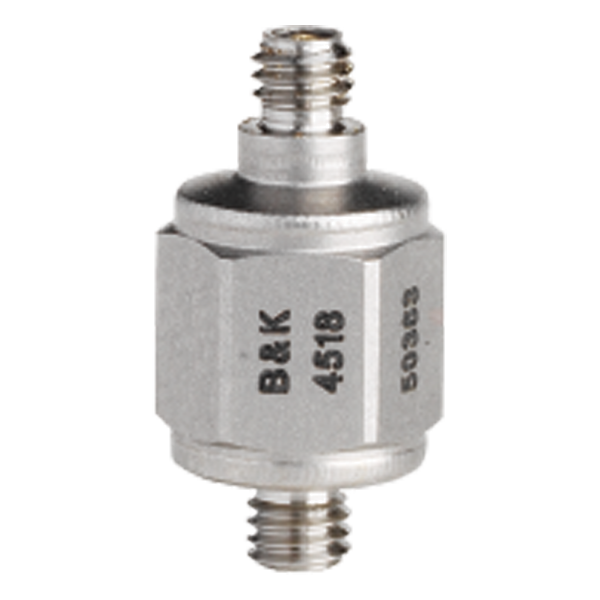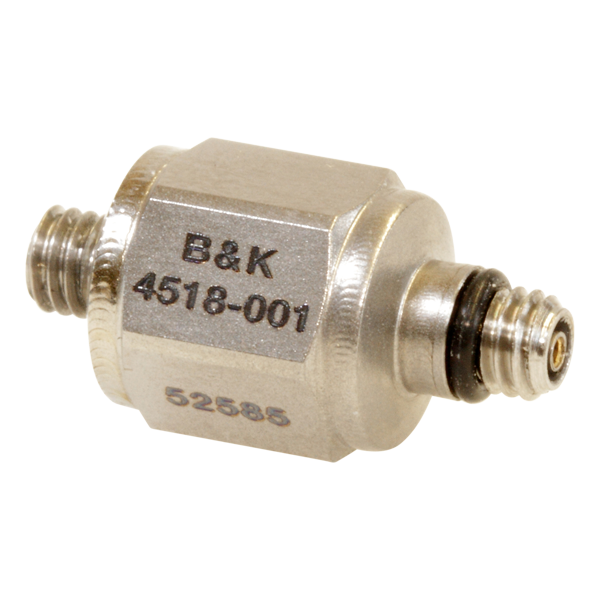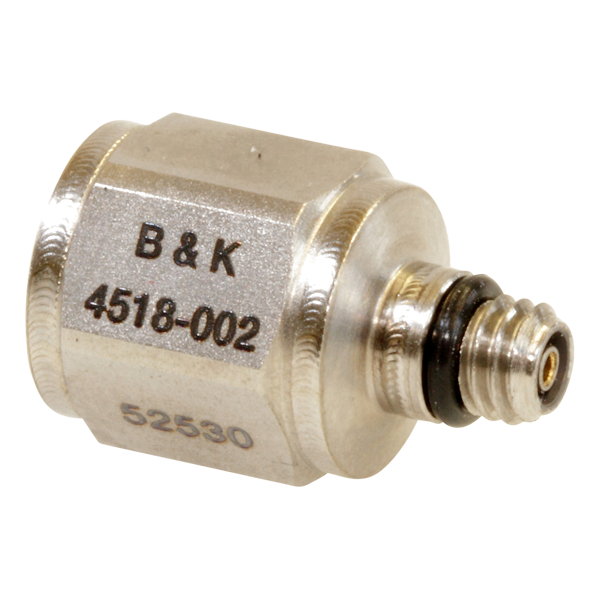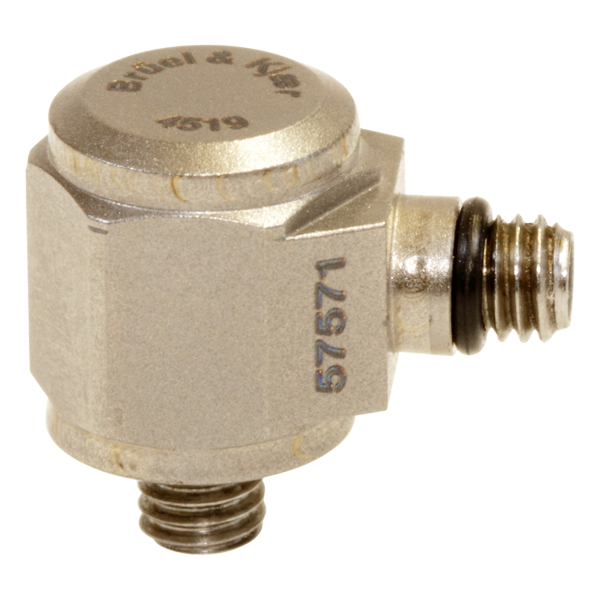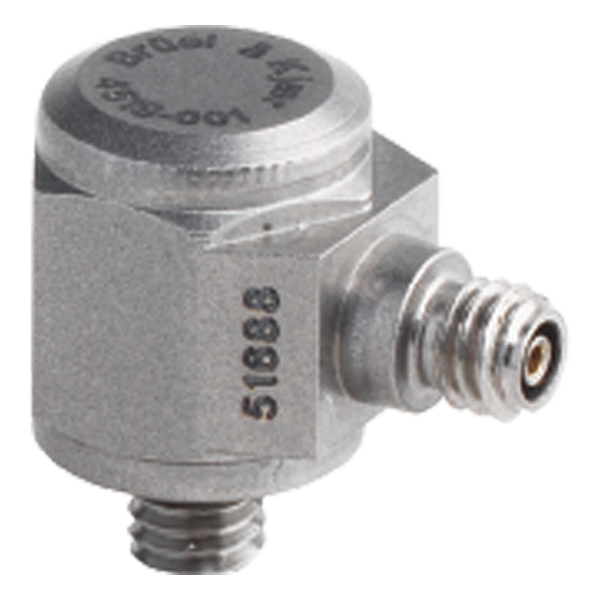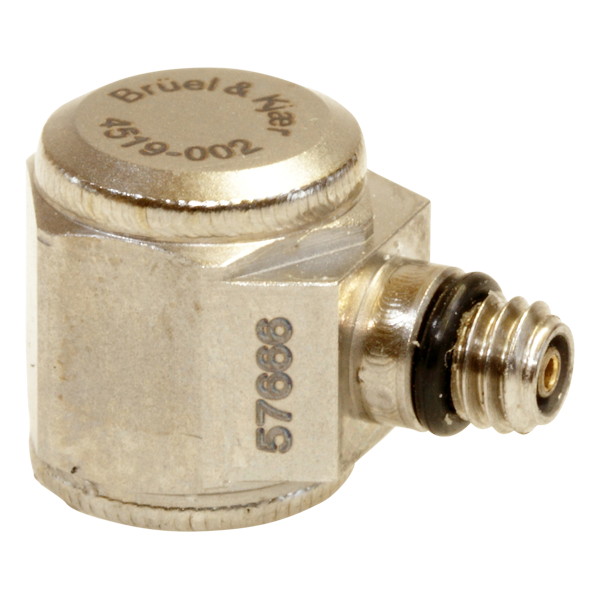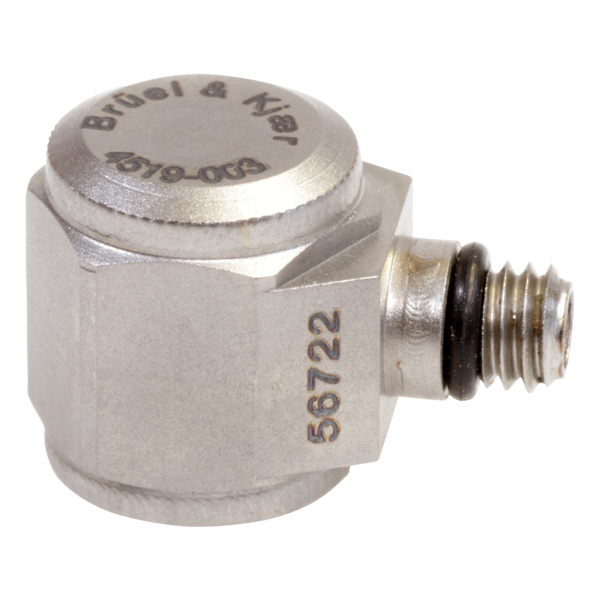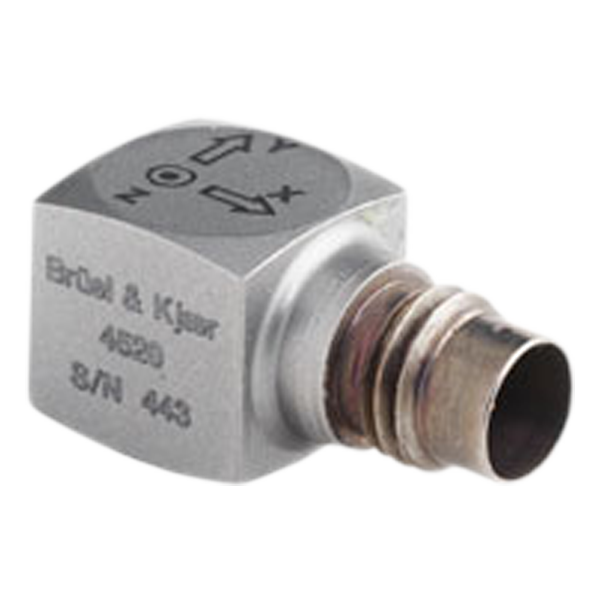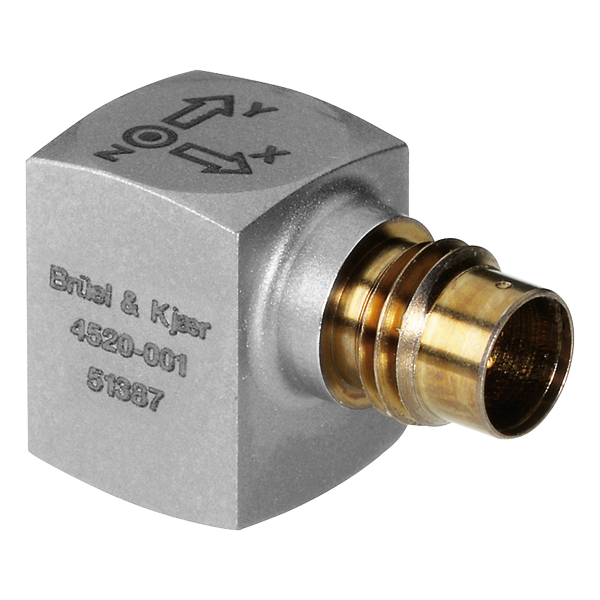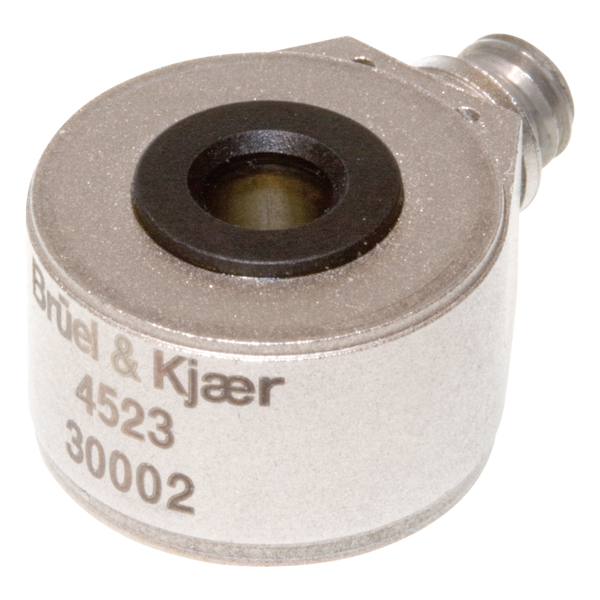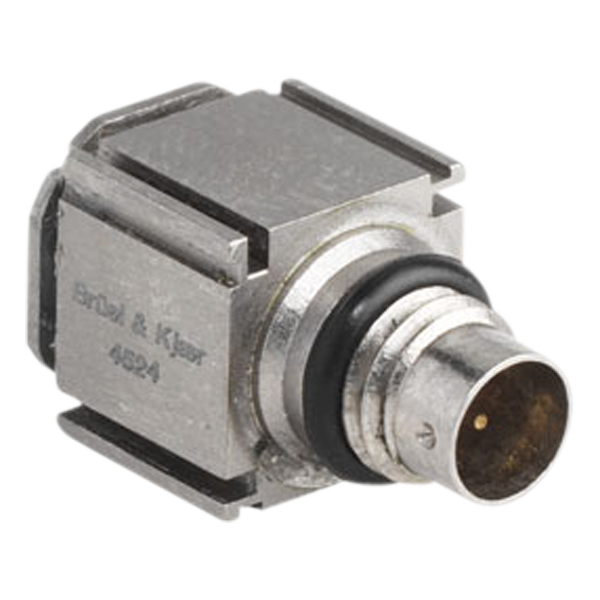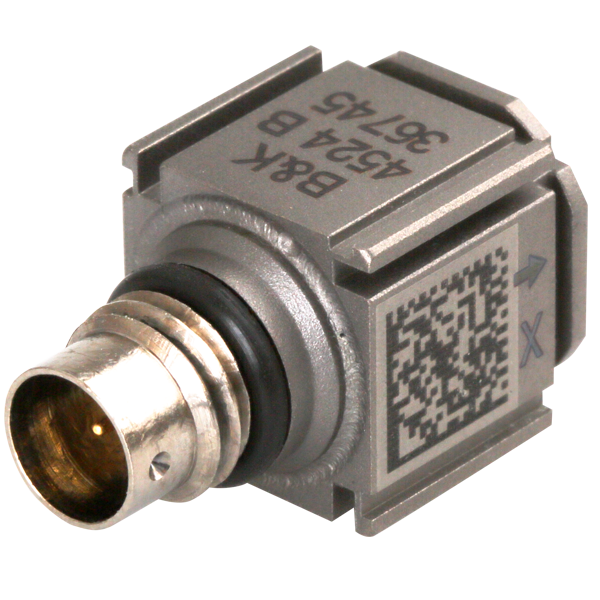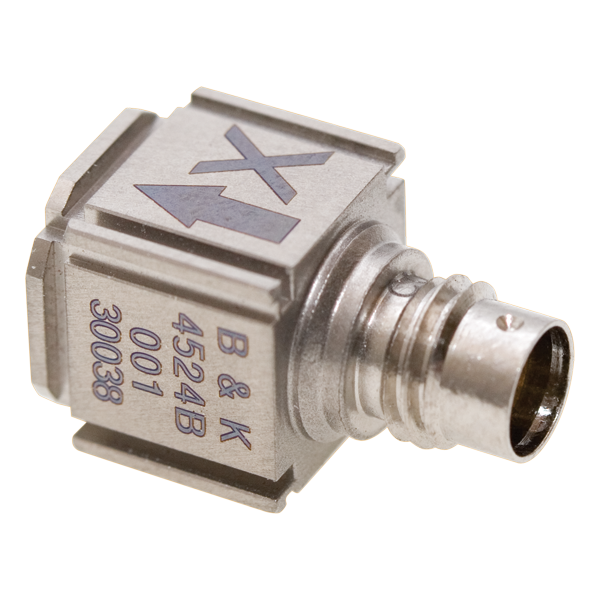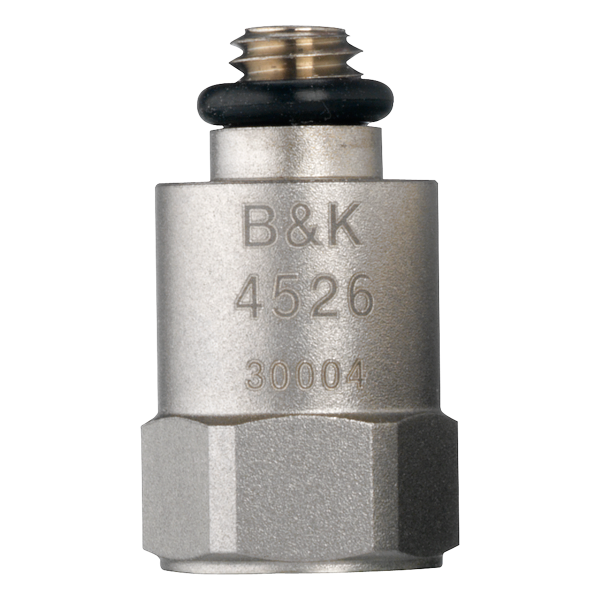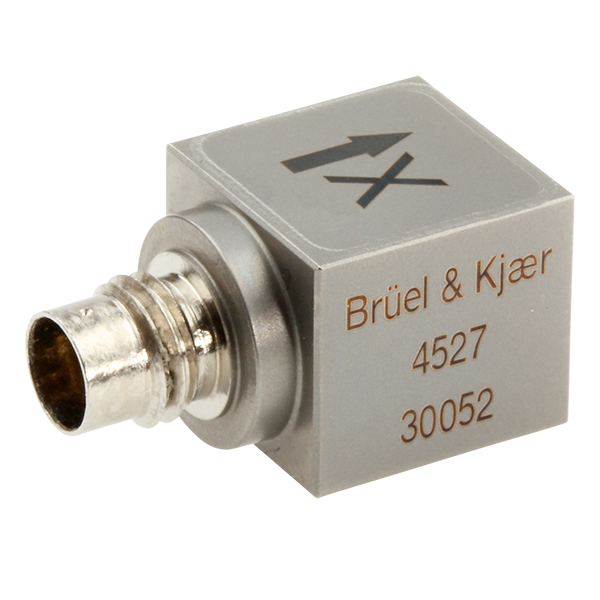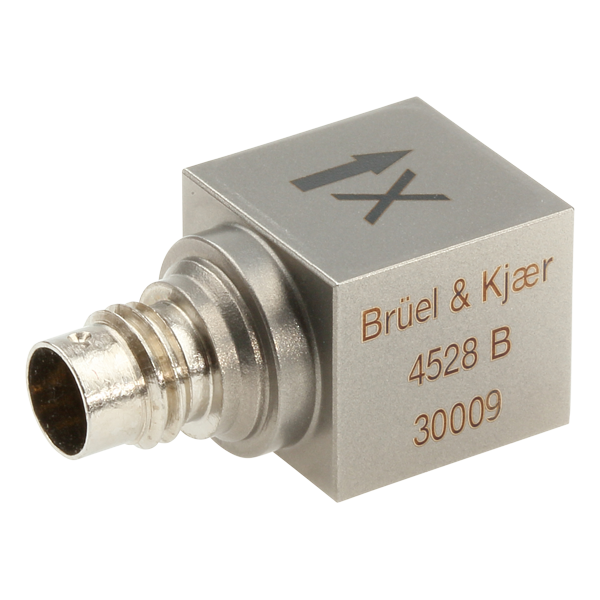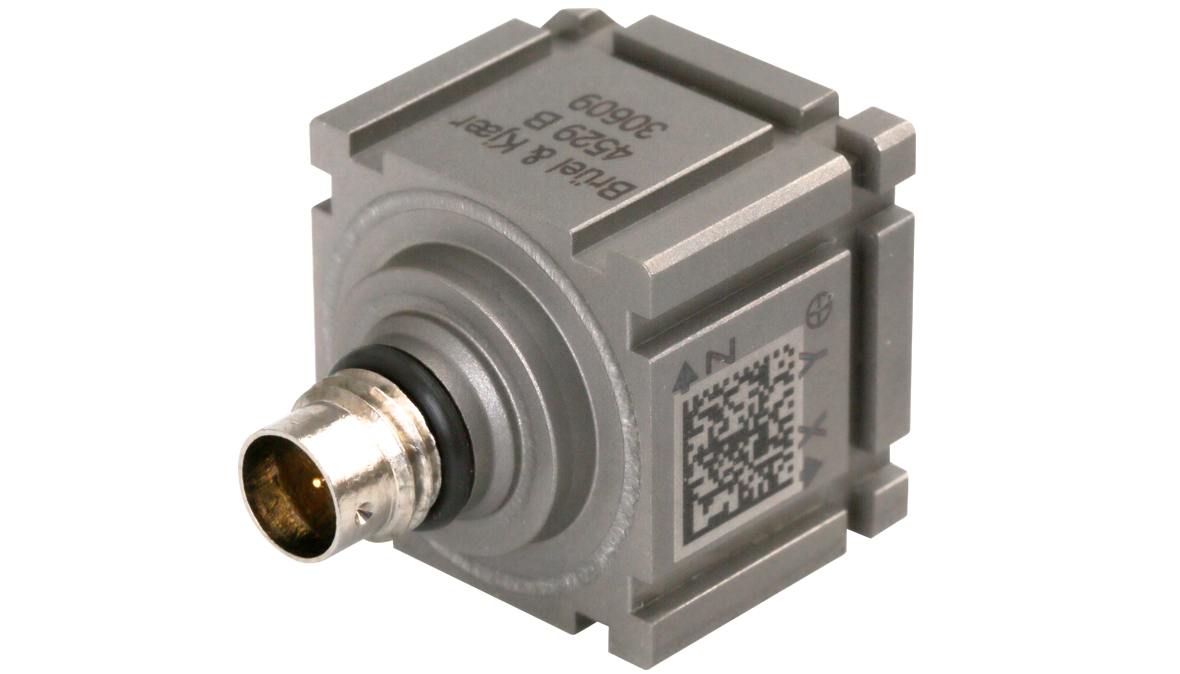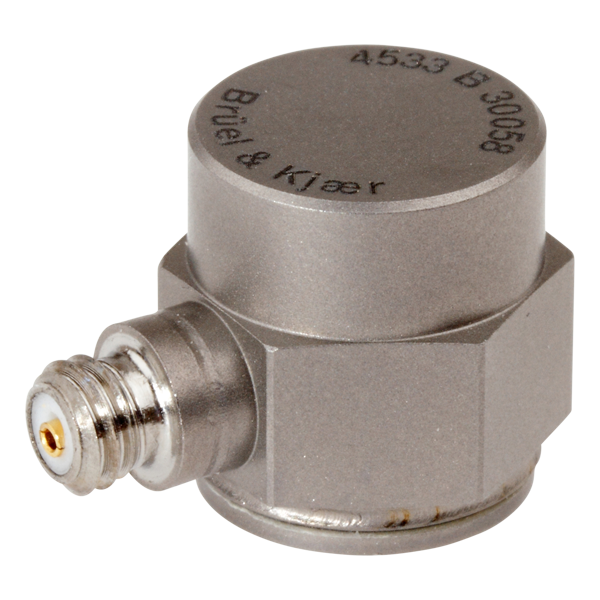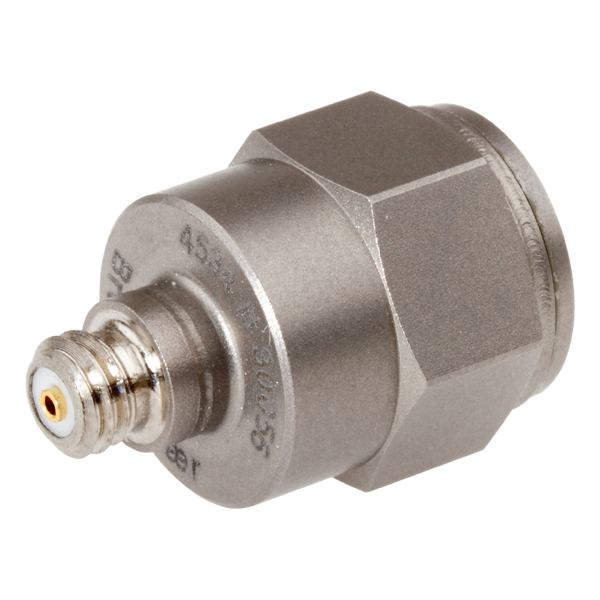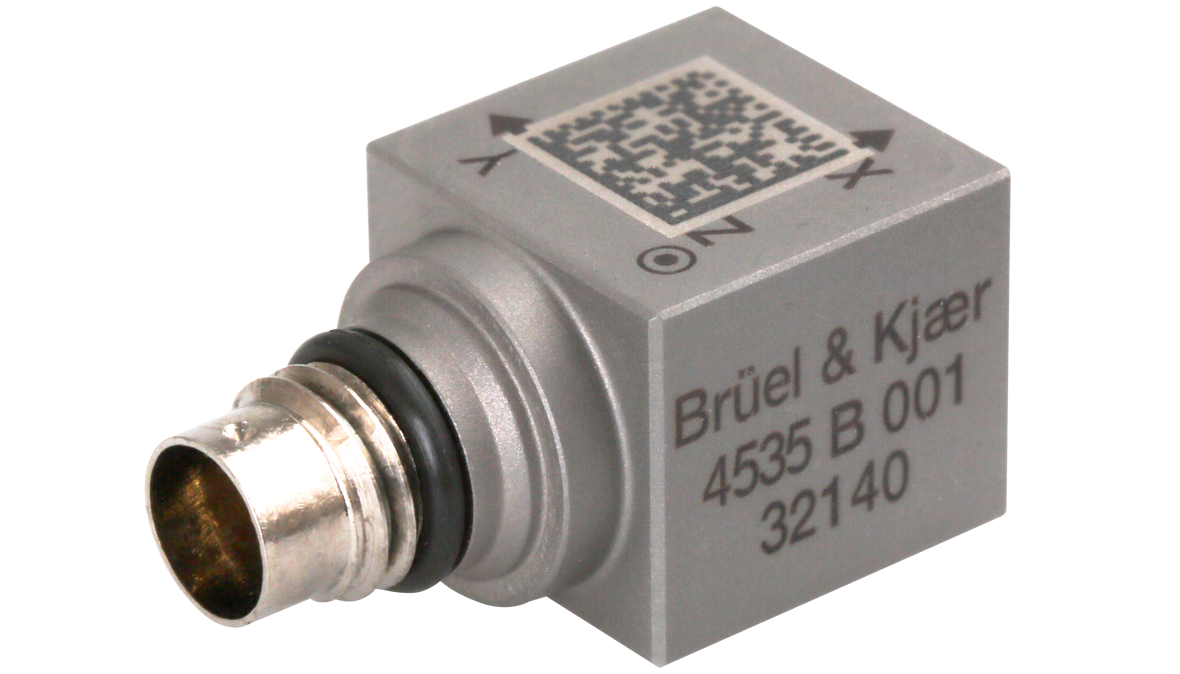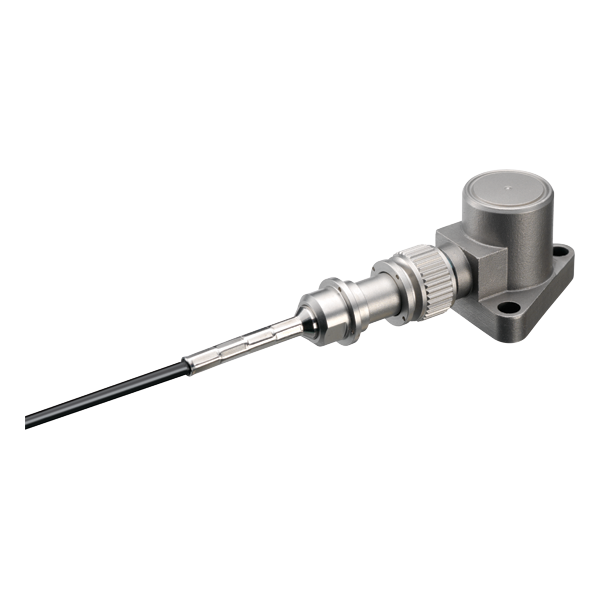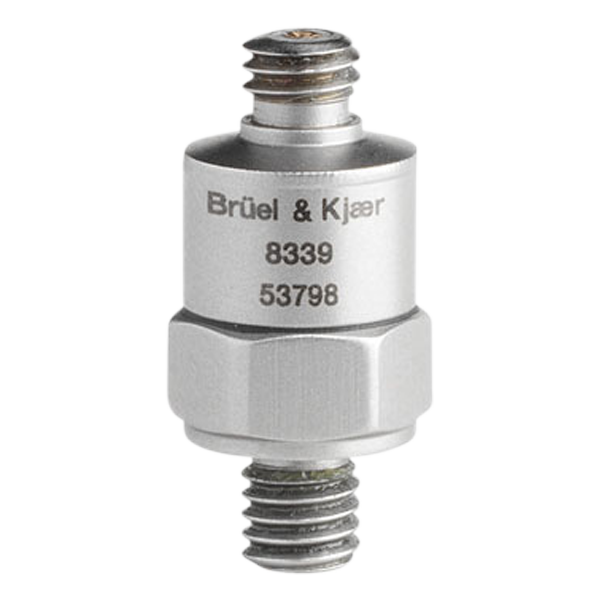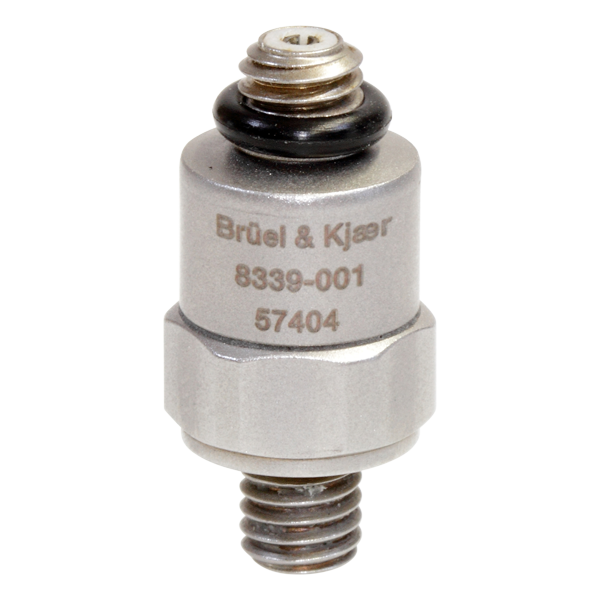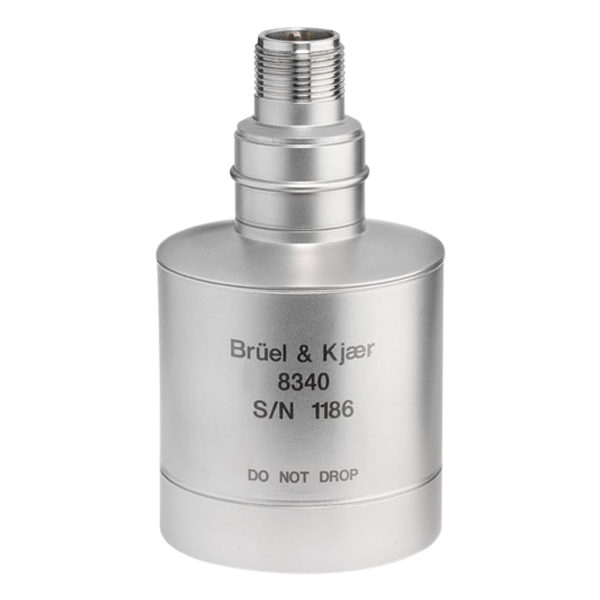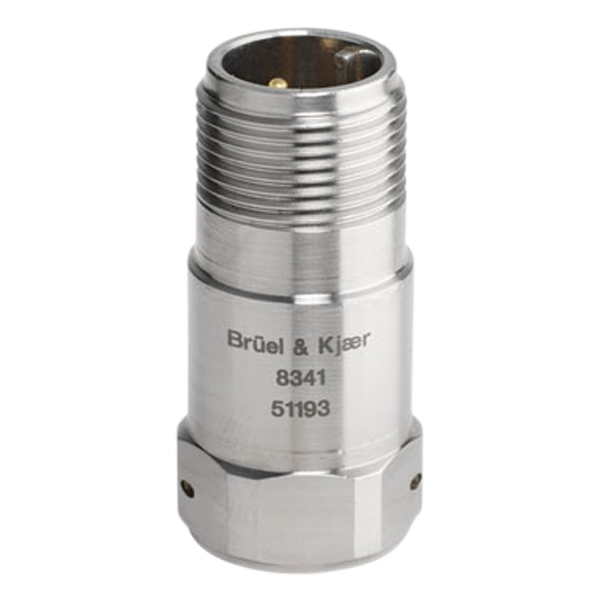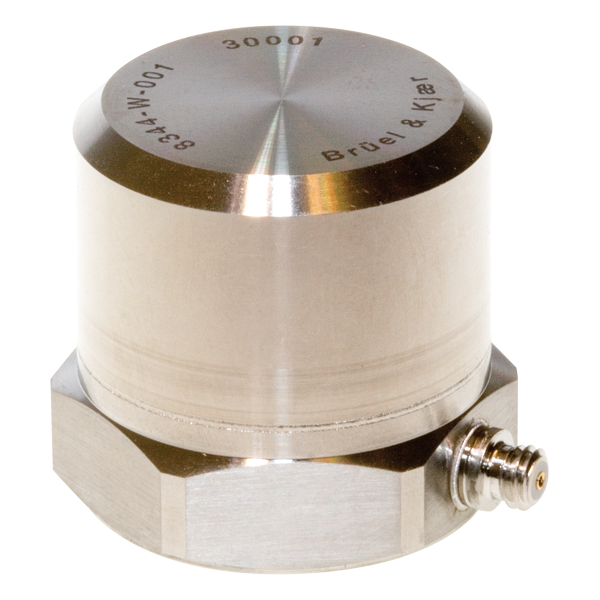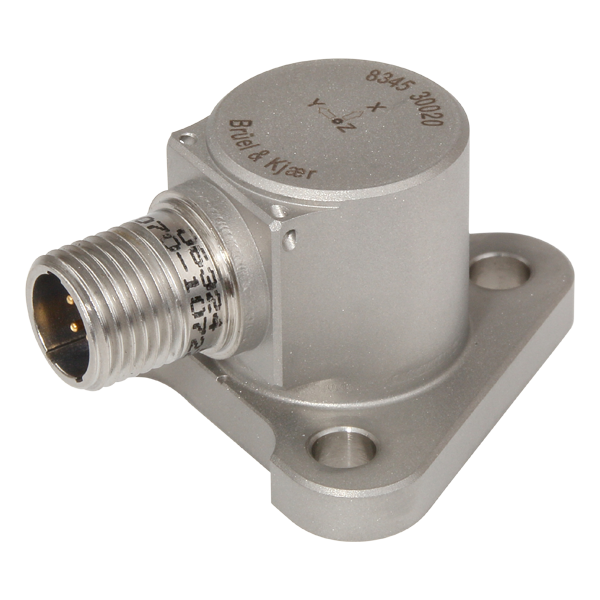Piezoelectric CCLD / IEPE Accelerometers
CCLD accelerometers are PE charge accelerometers (also refereed to as IEPE accelerometers) with integral preamplifiers that have output signals in the form of low impedance voltage output. Most Brüel & Kjær CCCLD accelerometers are hermetically sealed to protect against environmental contamination, they have low susceptibility to radio frequency, electromagnetic radiation and low a impedance output due to the built-in amplifier. This allows the use of inexpensive, and long, coaxial cables.
Affiner la sélection de produits
-
TYPE 4394
Accéléromètre CCLD piézoélectrique miniature, base isolée, incl. câble
Conçu pour les mesures sur structures légères soumises à des vibrations relativement élevées et à haute fréquence
- Freq. range : 1 – 25000 Hz
- Temperature : -50 – 125 ℃
- Weight : 2.9 gram
- Sensitivity : 1 mV/ms^-2
- Maximum Operational Level (peak) : 500 g
-
TYPE 4397
Accéléromètre miniature 1mV / ms-2, avec électronique interne CCLD, compatible ICP ©, incl. câble
Conçu pour les mesures sur structures légères soumises à des vibrations relativement élevées et à haute fréquence
- Freq. range : 1 – 25000 Hz
- Temperature : -50 – 125 ℃
- Weight : 2.4 gram
- Sensitivity : 1 mV/ms^-2
- Maximum Operational Level (peak) : 750 g
-
TYPE 4397-A
Accéléromètre CCLD piézoélectrique miniature, connecteur latéral, excl. câble
Conçu pour les mesures de chocs et de vibrations.
- Freq. range : 1 – 25000 Hz
- Temperature : -50 – 125 ℃
- Weight : 2.4 gram
- Sensitivity : 1 mV/ms^-2
- Maximum Operational Level (peak) : 500 g
-
TYPE 4504-A
Accéléromètre triaxial piézoélectrique CCLD, excl. câble
Conçu pour les mesures de vibration généralistes
- Freq. range : 1 – 9000 Hz
- Temperature : -50 – 125 ℃
- Weight : 15 gram
- Sensitivity : 1 mV/ms^-2
- Maximum Operational Level (peak) : 500 g
-
TYPE 4506-B-003
Accéléromètre CCLD piézoélectrique triaxial miniature, TEDS, 500mV / g, excl. câble
Conçu pour l'analyse structurelle dans l'industrie automobile.
- Freq. range : 0.3 – 2000 Hz
- Temperature : -54 – 100 ℃
- Weight : 18 gram
- Sensitivity : 50 mV/ms^-2
- Maximum Operational Level (peak) : 14 g
-
TYPE 4507-B
Accéléromètre piézoélectrique CCLD, TEDS, 1mV / g, connecteur latéral, 1 emplacement, excl. câble
Conçu pour les mesures en analyse modale.
- Freq. range : 0.3 – 6000 Hz
- Temperature : -54 – 121 ℃
- Weight : 4.8 gram
- Sensitivity : 10 mV/ms^-2
- Maximum Operational Level (peak) : 70 g
-
TYPE 4507-B-001
Accéléromètre piézoélectrique CCLD, TEDS, 0,1 mV / g, 1 fente, excl. câble
Conçu pour les mesures en analyse modale.
- Freq. range : 0.1 – 6000 Hz
- Temperature : -54 – 121 ℃
- Weight : 4.8 gram
- Sensitivity : 1 mV/ms^-2
- Maximum Operational Level (peak) : 700 g
-
TYPE 4507-B-002
Accéléromètre piézoélectrique CCLD, TEDS, 1000mV / g, connecteur latéral, 1 emplacement, excl. câble
Conçu pour les mesures en analyse modale.
- Freq. range : 0.4 – 6000 Hz
- Temperature : -54 – 100 ℃
- Weight : 4.8 gram
- Sensitivity : 100 mV/ms^-2
- Maximum Operational Level (peak) : 7 g
-
TYPE 4507-B-003
Accéléromètre piézoélectrique CCLD, TEDS, 1mV / g, connecteur latéral, sans fente, excl. câble.
Conçu pour les mesures en analyse modale.
- Freq. range : 0.3 – 6000 Hz
- Temperature : -54 – 121 ℃
- Weight : 4.9 gram
- Sensitivity : 10 mV/ms^-2
- Maximum Operational Level (peak) : 70 g
-
TYPE 4507-B-004
Accéléromètre CCLD type 4507-B-004
Conçu pour les mesures en analyse modale.
- Freq. range : 0.3 – 6000 Hz
- Temperature : -54 – 121 ℃
- Weight : 4.6 gram
- Sensitivity : 10 mV/ms^-2
- Maximum Operational Level (peak) : 70 g
-
TYPE 4507-B-005
Accéléromètre piézoélectrique CCLD, TEDS, 1000mV / g, connecteur latéral, excl. câble
Conçu pour les mesures en analyse modale.
- Freq. range : 0.4 – 6000 Hz
- Temperature : -54 – 100 ℃
- Weight : 4.6 gram
- Sensitivity : 100 mV/ms^-2
- Maximum Operational Level (peak) : 7 g
-
TYPE 4507-B-006
Accéléromètre piézoélectrique CCLD, TEDS, 5mV / g, connecteur latéral, excl. câble
Conçu pour les mesures en analyse modale.
- Freq. range : 0.2 – 6000 Hz
- Temperature : -54 – 100 ℃
- Weight : 46 gram
- Sensitivity : 50 mV/ms^-2
- Maximum Operational Level (peak) : 14 g
-
TYPE 4508-B
Conçu pour les mesures en analyse modale.
- Freq. range : 0.3 – 8000 Hz
- Temperature : -54 – 121 ℃
- Weight : 4.8 gram
- Sensitivity : 10 mV/ms^-2
- Maximum Operational Level (peak) : 70 g
-
TYPE 4508-B-001
Conçu pour les mesures en analyse modale.
- Freq. range : 0.1 – 8000 Hz
- Temperature : -54 – 121 ℃
- Weight : 4.8 gram
- Sensitivity : 1 mV/ms^-2
- Maximum Operational Level (peak) : 700 g
-
TYPE 4508-B-002
Conçu pour les mesures en analyse modale.
- Freq. range : 0.4 – 8000 Hz
- Temperature : -54 – 100 ℃
- Weight : 4.8 gram
- Sensitivity : 100 mV/ms^-2
- Maximum Operational Level (peak) : 7 g
-
TYPE 4508-B-003
Accéléromètre piézoélectrique CCLD, TEDS, 100 mV / g, sans fente, connecteur supérieur, excl. câble
Conçu pour les mesures en analyse modale.
- Freq. range : 0.3 – 8000 Hz
- Temperature : -54 – 121 ℃
- Weight : 4.9 gram
- Sensitivity : 10 mV/ms^-2
- Maximum Operational Level (peak) : 71 g
-
TYPE 4508-B-004
Conçu pour les mesures en analyse modale.
- Freq. range : 0.2 – 8000 Hz
- Temperature : -54 – 100 ℃
- Weight : 4.8 gram
- Sensitivity : 50 mV/ms^-2
- Maximum Operational Level (peak) : 14 g
-
TYPE 4511-001
Conçu pour les applications de test en vol et la mesure dans des environnements difficiles.
- Freq. range : 1 – 15000 Hz
- Temperature : -54 – 150 ℃
- Weight : 35 gram
- Sensitivity : 1 mV/ms^-2
- Maximum Operational Level (peak) : 500 g
-
TYPE 4515-B
Accéléromètre de siège triaxial CCLD 100 mV / g, TEDS, avec câble intégré de 3 m
Conçu pour les mesures de vibrations sur corps humain, sur le terrain ainsi que pour les tests et mesures dans les véhicules de transport de passagers et véhicules utilitaires
- Freq. range : 0.25 – 900 Hz
- Temperature : -10 – 70 ℃
- Weight : 345 gram
- Sensitivity : 10 mV/ms^-2
- Maximum Operational Level (peak) : 500 g
-
TYPE 4515-B-002
Accéléromètre de siège Triaxial DeltaTron ™ 100 mV / g, TEDS, avec câble intégré de 3 m
Conçu pour les mesures de vibrations sur corps humain, sur le terrain ainsi que pour les tests et mesures dans les véhicules de transport de passagers et véhicules utilitaires
- Freq. range : 0.25 – 900 Hz
- Temperature : -10 – 70 ℃
- Weight : 345 gram
- Sensitivity : 10 mV/ms^-2
- Maximum Operational Level (peak) : 500 g
-
TYPE 4516
Accéléromètre CCLD miniature, 10 mV / g, support adhésif, câble intégré
Conçu pour les mesures en espaces confinés et de structures fragiles.
- Freq. range : 1 – 20000 Hz
- Temperature : -51 – 121 ℃
- Weight : 1.5 gram
- Sensitivity : 1.02 mV/ms^-2
- Maximum Operational Level (peak) : 500 g
-
TYPE 4517
Accéléromètre CCLD à larme miniature, 10 mV / g, incl. câble
Conçu pour les mesures en espaces confinés et de structures fragiles.
- Freq. range : 1 – 20000 Hz
- Temperature : -55 – 121 ℃
- Weight : 0.65 gram
- Sensitivity : 1.02 mV/ms^-2
- Maximum Operational Level (peak) : 500 g
-
TYPE 4517-002
Accéléromètre CCLD à larme miniature, 10 mV / g, hermétique, incl. Câble amovible de 1 m
Conçu pour des mesures dans des espaces confinés et des structures délicates.
- Freq. range : 1 – 20000 Hz
- Temperature : -55 – 121 ℃
- Weight : 0.7 gram
- Sensitivity : 1.02 mV/ms^-2
- Maximum Operational Level (peak) : 500 g
-
TYPE 4518
Conçu pour des mesures dans des espaces confinés et des structures délicates.
- Freq. range : 1 – 20000 Hz
- Temperature : -51 – 121 ℃
- Weight : 1.5 gram
- Sensitivity : 1.02 mV/ms^-2
- Maximum Operational Level (peak) : 500 g
-
TYPE 4518-001
Conçu pour des mesures dans des espaces confinés et des structures délicates.
- Freq. range : 1 – 20000 Hz
- Temperature : -51 – 100 ℃
- Weight : 1.5 gram
- Sensitivity : 10.2 mV/ms^-2
- Maximum Operational Level (peak) : 50 g
-
TYPE 4518-002
Conçu pour des mesures dans des espaces confinés et des structures délicates.
- Freq. range : 1 – 20000 Hz
- Temperature : -51 – 121 ℃
- Weight : 1.45 gram
- Sensitivity : 1.02 mV/ms^-2
- Maximum Operational Level (peak) : 500 g
-
TYPE 4519
Conçu pour des mesures dans des espaces confinés et des structures délicates.
- Freq. range : 1 – 20000 Hz
- Temperature : -51 – 121 ℃
- Weight : 1.6 gram
- Sensitivity : 1.02 mV/ms^-2
- Maximum Operational Level (peak) : 500 g
-
TYPE 4519-001
Conçu pour des mesures dans des espaces confinés et des structures délicates.
- Freq. range : 1 – 20000 Hz
- Temperature : -51 – 100 ℃
- Weight : 1.6 gram
- Sensitivity : 10.2 mV/ms^-2
- Maximum Operational Level (peak) : 50 g
-
TYPE 4519-002
Conçu pour des mesures dans des espaces confinés et des structures délicates.
- Freq. range : 1 – 20000 Hz
- Temperature : -51 – 121 ℃
- Weight : 1.5 gram
- Sensitivity : 1.02 mV/ms^-2
- Maximum Operational Level (peak) : 500 g
-
TYPE 4519-003
Conçu pour des mesures dans des espaces confinés et des structures délicates.
- Freq. range : 1 – 20000 Hz
- Temperature : -51 – 100 ℃
- Weight : 1.5 gram
- Sensitivity : 10.2 mV/ms^-2
- Maximum Operational Level (peak) : 50 g
-
TYPE 4520
Accéléromètre CCLD triaxial cubique miniature, 10 mV / g
Conçu pour les mesures sur structures légères.
- Freq. range : 2 – 7000 Hz
- Temperature : -51 – 121 ℃
- Weight : 2.9 gram
- Sensitivity : 1.02 mV/ms^-2
- Maximum Operational Level (peak) : 500 g
-
TYPE 4520-001
Accéléromètre CCLD triaxial cubique miniature, 10 mV/g, orifice taraudé M3
Conçu pour les mesures sur structures légères.
- Freq. range : 2 – 7000 Hz
- Temperature : -51 – 121 ℃
- Weight : 4 gram
- Sensitivity : 1.02 mV/ms^-2
- Maximum Operational Level (peak) : 500 g
-
TYPE 4523
HUMS Accéléromètre piézoélectrique
Accélérométre Type 4523 a été spécifiquement conçu pour la surveillance des boîtes de transmission des hélicoptères (HUMS).
- Freq. range : 1 – 15000 Hz
- Temperature : -54 – 150 ℃
- Weight : 13.3 gram
- Sensitivity : 1 mV/ms^-2
- Maximum Operational Level (peak) : 500 g
-
TYPE 4524
Accéléromètre piézoélectrique CCLD triaxial
Conçu pour les mesures d'analyse structurelle.
- Freq. range : 0.25 – 3000 Hz
- Temperature : -54 – 100 ℃
- Weight : 4.4 gram
- Sensitivity : 10 mV/ms^-2
- Maximum Operational Level (peak) : 50 g
-
TYPE 4524-B
Accéléromètre piézoélectrique triaxial CCLD, TEDS
Conçu pour les mesures d'analyse structurelle.
- Freq. range : 0.25 – 3000 Hz
- Temperature : -54 – 100 ℃
- Weight : 4.4 gram
- Sensitivity : 10 mV/ms^-2
- Maximum Operational Level (peak) : 50 g
-
TYPE 4524-B-001
Accéléromètre CCLD triaxial cubique, TEDS, 1 mV / ms-2, excl. câble
Conçu pour les mesures d'analyse structurelle.
- Freq. range : 0.25 – 3000 Hz
- Temperature : -54 – 100 ℃
- Weight : 4.4 gram
- Sensitivity : 10 mV/g
- Maximum Operational Level (peak) : 500 g
-
TYPE 4526
Accéléromètre CCLD, 100 mV / g, plage 70 g, connecteur supérieur, excl. câble
Conçu pour une utilisation en fonctionnement continu haute température et avec une tension de polarisation stable, notamment sur les équipements complémentaires des turbines à gaz.
- Freq. range : 0.3 – 8000 Hz
- Temperature : -54 – 180 ℃
- Weight : 5 gram
- Sensitivity : 10 mV/ms^-2
- Maximum Operational Level (peak) : 70 g
-
TYPE 4526-001
Accéléromètre CCLD, 10 mV / g, gamme 700 g, connecteur supérieur, excl. câble
Conçu pour une utilisation en fonctionnement continu haute température et avec une tension de polarisation stable, notamment sur les équipements complémentaires des turbines à gaz.
- Freq. range : 0.1 – 8000 Hz
- Temperature : -54 – 180 ℃
- Weight : 5 gram
- Sensitivity : 1 mV/ms^-2
- Maximum Operational Level (peak) : 714 g
-
TYPE 4527
Conçu pour fonctionner en continu à 180°C (356°F) afin de répondre aux exigences environnementales les plus exigeantes.
- Freq. range : 0.3 – 10000 Hz
- Temperature : -60 – 180 ℃
- Weight : 6 gram
- Sensitivity : 1 mV/ms^-2
- Maximum Operational Level (peak) : 714 g
-
TYPE 4528-B
Accéléromètre Triax 10 mV / g avec TEDS
Conçu pour fonctionner en continu à 165°C (329°F) afin de répondre aux conditions environnementales les plus exigeantes.
- Freq. range : 0.3 – 10000 Hz
- Temperature : -60 – 165 ℃
- Weight : 6 gram
- Sensitivity : 1 mV/ms^-2
- Maximum Operational Level (peak) : 714 g
-
TYPE 4529-B
Grâce à sa gamme dynamique élevée, le Type 4529 couvre de nombreuses applications, notamment pour les essais sur route et modaux.
- Freq. range : 0.3 – 12800 Hz
- Temperature : -60 – 125 ℃
- Weight : 14.5 gram
- Sensitivity : 10 mV/ms^-2
- Maximum Operational Level (peak) : 71 g
-
TYPE 4529-B-001
Grâce à sa gamme dynamique élevée, le Type 4529-B-001 couvre un grand nombre d'applications, notamment les essais sur route et modaux.
- Freq. range : 0.3 – 12800 Hz
- Temperature : -60 – 125 ℃
- Weight : 14.5 gram
- Sensitivity : 1 mV/ms^-2
- Maximum Operational Level (peak) : 710 g
-
TYPE 4533-B
Conçu pour une large gamme de fréquences, offre un faible niveau de bruit et une faible sensibilité aux influences environnementales.
- Freq. range : 0.2 – 12800 Hz
- Temperature : -55 – 125 ℃
- Weight : 8.6 gram
- Sensitivity : 1 mV/ms^-2
- Maximum Operational Level (peak) : 714 g
-
TYPE 4534-B
Accéléromètre CCLD, 1 mV / ms ^ -2
Conçu pour une large gamme de fréquences, offre un faible niveau de bruit et une faible sensibilité aux influences environnementales.
- Freq. range : 0.2 – 12800 Hz
- Temperature : -55 – 125 ℃
- Weight : 8.6 gram
- Sensitivity : 1 mV/ms^-2
- Maximum Operational Level (peak) : 714 g
-
TYPE 4534-B-001
Accéléromètre CCLD, 10 mV / ms ^ -2
Conçu pour une large gamme de fréquences, offre un faible niveau de bruit et une faible sensibilité aux influences environnementales.
- Freq. range : 0.2 – 12800 Hz
- Temperature : -55 – 125 ℃
- Weight : 8.6 gram
- Sensitivity : 10 mV/ms^-2
- Maximum Operational Level (peak) : 71 g
-
TYPE 4534-B-002
Accéléromètre CCLD, 50 mV / ms ^ -2
Cet accéléromètre offre une large gamme de fréquences, un faible niveau de bruit et une faible sensibilité aux influences environnementales.
- Freq. range : 0.2 – 12800 Hz
- Temperature : -55 – 125 ℃
- Weight : 8.6 gram
- Sensitivity : 50 mV/ms^-2
- Maximum Operational Level (peak) : 14 g
-
TYPE 4535-B
Accéléromètre CCLD triaxial à usage général, TEDS, 9,8 mV / g, sans câble
Conçu pour simplifier vos essais et couvrent la plupart des divers besoins d'un laboratoire d'essai avec un seul capteur.
- Freq. range : 0.3 – 10000 Hz
- Temperature : -60 – 125 ℃
- Weight : 6 gram
- Sensitivity : 1 mV/ms^-2
- Maximum Operational Level (peak) : 714 g
-
TYPE 4535-B-001
Accéléromètre CCLD triaxial avec TEDS (98 mV/g)
Conçu pour simplifier vos essais et couvrent la plupart des divers besoins d'un laboratoire d'essai avec un seul capteur. Le Type 4535-B-001 comprend un code Data Matrix (ou QR Code) permettant de simplifier et d'automatiser les installations pour les essais multivoies.
- Freq. range : 0.3 – 10000 Hz
- Temperature : -60 – 125 ℃
- Weight : 6 gram
- Sensitivity : 10 mV/ms^-2
- Maximum Operational Level (peak) : 71 g
-
TYPE 8324-G
Accéléromètres piézoélectriques de types 8324-G et 8324-G-100
Conçu pour les mesures de vibrations en environnements industriels difficiles.
- Freq. range : 1 – 9000 Hz
- Temperature : -196 – 250 ℃
- Weight : 91 gram
- Sensitivity : 1 mV/ms^-2
- Maximum Operational Level (peak) : 2000 g
-
TYPE 8339
Accéléromètre de choc CCLD, .25 mV/g, connecteur sur la partie supérieure sans câble
Conçu pour mesurer les vibrations en continu de niveau élevé, les chocs mécaniques et les pyrochocs.
- Freq. range : 1 – 20000 Hz
- Temperature : -51 – 121 ℃
- Weight : 5.8 gram
- Sensitivity : 0.025 mV/ms^-2
- Maximum Operational Level (peak) : 20000 g
-
TYPE 8339-001
Accéléromètre de choc CCLD, 0,1 mV/g, connecteur sur la partie supérieure, sans câble
Conçu pour mesurer les vibrations en continu de niveau élevé, les chocs mécaniques et les pyrochocs.
- Freq. range : 1 – 20000 Hz
- Temperature : -51 – 121 ℃
- Weight : 5.8 gram
- Sensitivity : 0.01 mV/ms^-2
- Maximum Operational Level (peak) : 50000 g
-
TYPE 8340
Accéléromètre sismique CCLD, 10 V/g, connecteur sur la partie supérieure, sans câble
Conçu pour offrir une grande sensibilité et un excellent rapport signal/bruit, cet accéléromètre est parfaitement adaptée aux mesures sur de grandes structures à très basse fréquence et aux application de mesure de l'activité sismique de faible niveau.
- Freq. range : 0.1 – 1500 Hz
- Temperature : -51 – 74 ℃
- Weight : 775 gram
- Sensitivity : 1 mV/ms^-2
- Maximum Operational Level (peak) : 0.5 g
-
TYPE 8341
Accéléromètre industriel CCLD, 100 mV/g, connecteur sur la partie supérieure, hermétique, sans câble
Conçu pour le contrôle actif des vibrations en vol sur les avions rotors et voilure fixe et pour les applications industrielles.
- Freq. range : 0.3 – 10000 Hz
- Temperature : -50 – 121 ℃
- Weight : 41 gram
- Sensitivity : 10 mV/ms^-2
- Maximum Operational Level (peak) : 50 g
-
TYPE 8344
Accéléromètre piézoélectrique, TEDS
Conçu pour les mesures de faible niveau, offre un faible bruit et une haute sensibilité.
- Freq. range : 0.2 – 3000 Hz
- Temperature : -50 – 100 ℃
- Weight : 176 gram
- Sensitivity : 250 mV/ms^-2
- Maximum Operational Level (peak) : 2.6 g
-
TYPE 8345
Accéléromètre triaxial CDFT Type 8345
Conçu pour fonctionner en environnements extrêmes et doté d'un robuste connecteur 4 broches Glenair® série 800 pour applications industrielles.
- Freq. range : 2 – 2000 Hz
- Temperature : -54 – 125 ℃
- Weight : 40 gram
- Sensitivity : 98 mV/g
- Maximum Operational Level (peak) : 1000 µg
What are CCLD Accelerometers?
CCLD is a generic name identifying accelerometers (and is also refereed to as IEPE accelerometers) and CCLD Signal conditioning equipment that operate on a constant-current power supply and give output signals in the form of voltage modulation on the power supply line.
CCLD variants have built-in, low-noise preamplifiers that are made using thick-film technology. The preamplifiers comprise ASICs (application-specific integrated circuit) including a special reference voltage that ensures very stable bias voltage over the entire operating temperature range.
An obvious advantage of using CCLD equipment is that it allows you to use inexpensive cables.
The low-output impedance allows the use of long cables for connection between the accelerometer and the data acquisition hardware, ie. our Input DAQ Module (LAN-XI Type 3050).
Cables and Connectors for CCLD
For general, non-critical use, the following cables are recommended for use with CCLD variants:
- Single-screened Accelerometer Cable (AO-0463)
Flexible cable with coaxial connectors (male, 10 – 32 UNF), – 20, max. temperature: +80 °C (– 4 to +176 °F) - Coaxial Accelerometer Cable (AO-0531)
Flexible cable with coaxial connectors (male, 10 – 32 UNF) to BNC (male) connectors, max. temperature: –20 to +80 °C (– 4 to +176 °F) - Low-Noise Accelerometer Cable (AO-1382)
Double-screened cable with coaxial connectors (male, 10– 32 UNF), max. temperature: 250 °C (482 °F)
In order to distinguish individual accelerometers in a multichannel measurement setup, numbered cable markers (UA-1243) are available to fit cables that are 1.6 mm in diameter and coloured cable markers (UA-1244) are available to fit cables that are 1.9 to 2.2 mm in diameter.
Maximum Cable Length for CCLD
The maximum output voltage of a CCLD accelerometer when driving long cables depends on the supply current at which it is operating, and on the capacitive load due to the connecting cable.
The maximum cable length in metres (for distortion ≤1%) is given by:
L = 140000 x ls – 1 f x VoxCm
where:
Is = supply current (mA)
f = frequency (kHz)
Vo = output voltage (Vpeak)
Cm = cable capacitance (pF/m)

Contactez dès aujourd'hui votre interlocuteur Brüel & Kjær !

